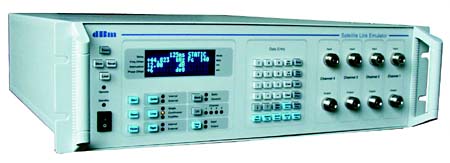Link Emulator Provides Signal Impairments For Earth Terminal, Satellite Payload Testing
Wayne, NJ -- dBm, LLC today introduced the SLE700 satellite link emulator that provides the transmission path and signal impairments required when testing satellite communications Earth terminals and satellite payloads during development and before deployment.
A complete transmission path may contain a single spacecraft and two earth terminals (and possibly other satellites) required to complete the link. To evaluate how the communications hardware will perform during service, characteristics such as propagation delay, fading, Doppler shift, and phase shift must be induced at precise levels and times to accurately mimic the conditions that occur as a satellite changes its position in the sky.

The SLE700 is typically embedded in a large closed-loop automated test system that performs hundreds of tests. dBm's first satellite link emulator, the SLE, has been a fundamental ingredient in these systems and has been used in development of virtually every major satellite communications system.
The SLE700 delivers higher RF performance than its predecessor in key areas. Maximum RF bandwidth is now 45 MHz versus 20 MHz, which allows it to accommodate the wideband modulation schemes employed in most current satcom systems. Signal-to-noise ratio has been improved by 15 dB, and rejection of spurious signals has been increased by 10 dB.
The SLE700 is a microprocessor-based system and uses solid-state memory rather than a hard drive for storage of test routines, which provides greater reliability. The SLE700 is easily integrated along with other instruments into PC-based satcom test systems in which the instruments are controlled by a PC-based test manager and reside on a LAN. The SLE700 can be controlled using user-created test scripts that make calls to the SLE700's function library, and is also supplied with PC-based software with a graphic user interface that allows the instrument to be controlled remotely, eliminating the need to write control software. The SLE700 operates either in static mode, in which a fixed set of conditions such as delay and frequency are entered, or in dynamic mode, in which the instrument runs the ephemeris data files that vary impairments to emulate actual conditions.
Seamless Delay
Propagation delay is the most important impairment induced by the SLE700, and also one of the most difficult to deliver seamlessly. In other link emulators, a digital delay line introduces phase discontinuities that with CDMA or CW modulation schemes can cause the system to lose lock. In contrast, the SLE700 provides seamless changes in phase without phase discontinuities. Rate and magnitude of the delay change are easily programmable, and the resulting output signal smoothly changes from the initial to the final delay value with less than 1 ns deviation from ideal at any point in time. The range of the delay slew rate is 0.003 ps/s up to 20 ms/s and the range of the absolute delay 100 ìs to 698 ms. The delay varies in time, and creates true Doppler shift and chip-period variations, accurately simulating Doppler shift that occurs as the spacecraft's position changes in relation to the earth terminals.
The SLE700 can be configured with up to four independent channels. Its standard center frequency is either 70 or 140 MHz, and other frequencies through K band can be accommodated with dBm's external frequency converters that can be directly controlled from the instrument's front panel. If noise impairments are required, one of dBm's CNG Series carrier-to-noise generators can be employed to apply additive white Gaussian noise (AWGN) to the signals. The company can also provide a complete satellite channel simulator that includes the SLE700, a CNG carrier-to-noise generator, and a multipath fading emulator.
A data generation program called SATGEN is also available that can be programmed for any orbit and ground station coordinates. SATGEN incorporates preset parameters for many major satellite systems, as well as multiple ground station coordinates and path loss models. The models are used to generate the ephemeris data files that allow the SLE700 to simulate complex communications paths between an orbiting satellite and a ground station. SATGEN runs on any Microsoft Windows-based PC.
Source: dBm, LLC
